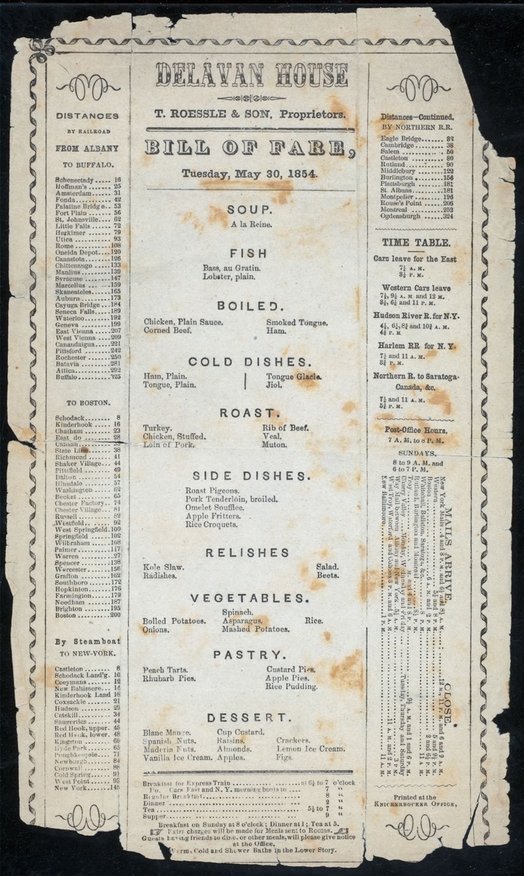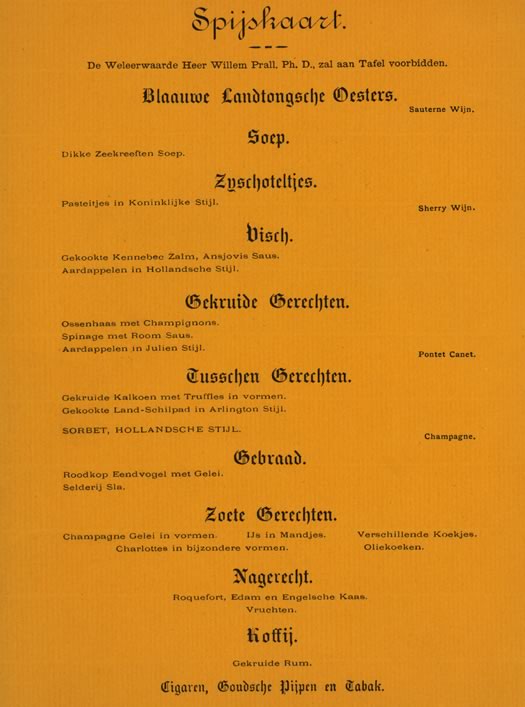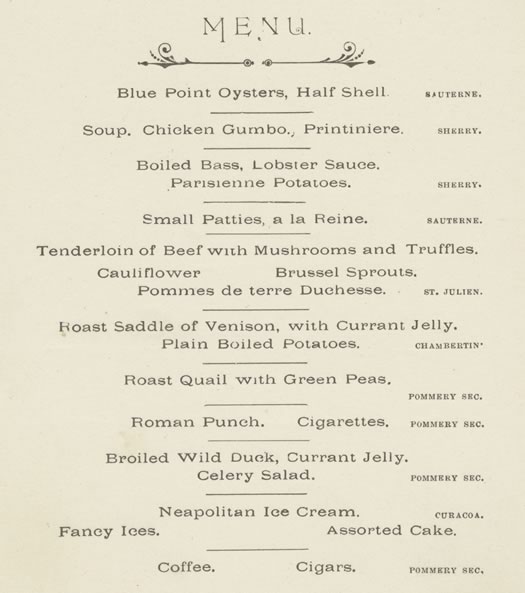What was on the menu in Albany back then

History so often is about dates and places and battles and famous people. But we often find ourselves curious about the day-to-day things from way back. What were people's houses like? What did they do for fun? What were they eating?
We had that last question in mind when we came across a group of historical menus that are online as part of the New York Public Library's collection. And a handful of them are from hotels and halls in Albany during the last 1800s and early 1900s.
So... what was on the menu?
Delavan House daily menu: May 30, 1884
The Delavan House was located on the east side Broadway between Steuben and Montgomery, and it was one of Albany's top hotels during the second half of the 19th century. (The person who started it -- Edward C. Delavan -- was an outspoken figure in the temperance movement, which must have been a point of friction in operating such an establishment.) It was destroyed in a fire in 1894.
(There's a larger version of this menu above in large format.)

One of the items that caught our eye was "Soup A La Reine," which apparently is a creamy chicken and rice soup.
Holland Society of New York dinner at the Delavan House: February 13, 1889
This menu -- for "The Beverwyck Dinner" -- was, appropriately, printed in both English and Dutch (both are below). We're intrigued by a bit by the dish "Terrapin, Stewed, Arlington Style" -- we weren't able to figure out what it was during a little bit of digging, but it appears to have had a relatively short run of popularity during the late 1800s.


Stanwix Hall Hotel dinner: June 21, 1880
The Stanwix Hall Hotel was on Broadway at Maiden Lane. Note that macaroni and cheese is on this menu.

Albany Zouave Cadets dinner at The Windsor: December 6, 1888
The Albany Zouave Cadets were a New York Militia infantry regiment that fought in the Civil War. This was a dinner organized by the "Officers of the Old Guard" -- Edward B. Ten Broeck, president -- so, presumably, it was an opportunity for the men to get back together and socialize. The venue is listed on the menu as "The Windsor" -- and we're not sure about its location. (Maybe you know.)
You'll note that chicken gumbo is on this menu, which might seem a bit out of place. But the regiment primarily fought in Louisiana during the Civil War -- it was part of the Siege of Port Hudson -- so maybe the dish was a callback.

Medical Society of New York dinner at Odd Fellows Hall: January 31, 1906
The Odd Fellows are a fraternal organization that dates back to 1819. In the early 1900s the org's hall in Albany was at Lodge and Howard streets (where the county office building is now).
Maybe because this was a fancy doctors affair the menu was in French. Check out the rum sorbet (hey, now!) halfway down the menu.

Elks dinner at the Stanwix Hotel: February 21, 1906
This one is fun, if only because of the design of the menu. It looks like there's some solid comfort food on here, though we're curious about the "St. Julien." Update: chezjake and ace both point out below that it's a red Bordeaux wine.

____
Earlier on AOA
+ What did Albany eat in the 18th century?
+ Baking that Albany Cake
Hi there. Comments have been closed for this item. Still have something to say? Contact us.

Comments
St. Julien is a red Bordeaux wine from the Medoc region.
... said chezjake on Jan 12, 2016 at 5:51 PM | link
There's a couple of cool things about Stanwix Hall. First, it was opened by a perennial Albany-Dutch family—the Gansevoorts—in the very early 1800s. It was named after the fort defended by Colonel (and later General) Peter Gansevoort—Fort Stanwix (near Rome, New York)—at the Battle of Oriskany, during the American Revolution. Other than the town of Gansevoort, fans of “Moby-Dick†might recognize the Gansevoort name, as Peter was Herman Mellville’s maternal grandfather (that’s part of the the Melville/Albany connection, by the way.)
Prior to the opening of Albany’s long-lived hotel, Peter, and before that his father, operated another long running family business—a brewery—which originally made beer at the same location as the hotel, on Broadway. There are numerous Albany newspaper advertisements from the 1790s, placed by Gansevoort (and his partner Lockwood), advertising Ale (including bottled ale), Table Beer, and Draft, American and London Porter; and requesting barley, to be purchased at the highest price.
After the brewery has closed in the early 1800s, and while the hotel’s dome was being constructed, Albany residents joked that it was Harm Gansevoort’s (Peter’s father) old brewing kettle—the one he used to wash his breeches in!
How long running was the Gansevoorts foray into brewing, you ask? Quite a while. The patriarch of the family—Harman Hamanse (Gansevoort) started brewing in Beverwijck in the 1640s, and moved to his Handlers Street (today’s Broadway) location in the the 1650s. Do the math, that’s around 150 years!
... said Craig on Jan 12, 2016 at 7:12 PM | link
To follow on chezjake's post... a very good and pricey wine.
... said ace on Jan 13, 2016 at 9:16 AM | link
@chezjake, ace: Thanks for filling that in. I had figured it was some sort of dish -- or maybe it was "Mashed Potatoes St. Julien." But it makes sense it's a beverage as it's listed with the champagne and [Adirondack?] Water.
... said Greg on Jan 13, 2016 at 9:20 AM | link
It's fascinating to me that a mid-meal cigarette break and the after dinner cigar are listed on some of the dinner menus. Also that roast pigeons and broiled pork tenderloin were considered side dishes back then.
... said Amy on Jan 13, 2016 at 9:26 AM | link
A Terrapin is a type of turtle, of course, but as to "Arlington style" - who knows?
... said Alex on Jan 13, 2016 at 10:16 AM | link
Very interesting.......
... said Anna finley on Jan 13, 2016 at 11:08 AM | link
And rice was considered a vegetable. Also, pity the poor passenger pigeon -- its popularity on menus spelled its doom.
... said chrisck on Jan 13, 2016 at 12:28 PM | link
And you could order nuts for dessert!
... said Amy on Jan 13, 2016 at 1:02 PM | link
Some observations:
I wonder if T. Roessle and Son, proprietors of the Delavan House, were related to the celery grower for whom Roessleville (now part of the Town of Colonie) was named.
The railroad (and steamboat!) distances on the Delavan House menu are interesting. I didn't know Hoffman's had a train stop, or maybe a station.
Cool to see Saratoga Chips (and "Arondack Water") on the Elks dinner menu from 1906! What are "Bluepoints"? Isn't that a type of Siamese cat? :)
... said Ellen on Jan 13, 2016 at 1:11 PM | link
What I find interesting is these menus are not really that far off from what restaurants serve today. Simpler obviously, but still relatively similar to what one might find on an menu that focuses on American fare presently.
Spring lamb hash with poached egg. Sign me up!
... said Steve N. on Jan 13, 2016 at 1:45 PM | link
From what I could gather the turtle cooked "Arlington style" were stewed in and eaten sort of like oysters, right in the shell as they were smaller turtles.
... said Ken on Jan 13, 2016 at 2:34 PM | link
Ellen, yes, it is the same Theophilus Roessle.
http://albanyruralcemetery.blogspot.com/2012/11/theophilus-roessle-colonies-celery.html
... said Paula on Jan 13, 2016 at 5:40 PM | link
Ellen- strictly speaking, "Blue Points" were oysters harvested from on or near Blue Point Long island - but the term became diluted over the years and was applied to any oyster from Long Island Sound ...or indeed to Connecticut oysters
http://www.chefs-resources.com/seafood/oysters/atlantic-oysters/blue-point-oysters/
... said Eric Scheirer Stott on Jan 13, 2016 at 6:38 PM | link
Thanks, Paula and Eric, for responding to my questions!
... said Ellen on Jan 14, 2016 at 9:56 AM | link
Thank you wonderful friends from around the world who have since settled here and shared their flavors and colorful epicurean fare with us.
... said Cyril on Jan 14, 2016 at 1:43 PM | link